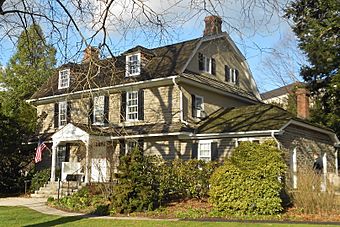Benjamin West Birthplace facts for kids
|
Benjamin West Birthplace
|
|

Benjamin West Birthplace, 2015
|
|
| Location | Swarthmore College campus, Swarthmore, Pennsylvania |
|---|---|
| Area | less than one acre |
| Built | c. 1724 |
| NRHP reference No. | 66000662 |
Quick facts for kids Significant dates |
|
| Added to NRHP | October 15, 1966 |
| Designated NHL | December 21, 1965 |
The Benjamin West Birthplace is a special old house. It is located on the campus of Swarthmore College in Swarthmore, Delaware County, Pennsylvania. This house is famous because it was the birthplace of a very important artist named Benjamin West (1738-1820).
Benjamin West was a great teacher and helper for many American painters. Artists like Gilbert Stuart and Charles Willson Peale learned a lot from him. Because of its history, the house was named a National Historic Landmark in 1965. It was also added to the National Register of Historic Places in 1966. Today, it helps visitors learn about Swarthmore College.
Contents
Benjamin West's Birthplace
What is the Benjamin West Birthplace?
The Benjamin West Birthplace is a two-and-a-half story stone house. It has a pointed roof with two small windows on each side. The front of the house has five sections, with the main door in the middle. A small roof covers the entrance.
The inside of the house was rebuilt after a fire in 1874. So, the original 1700s features are not there anymore. After the fire, a new section was added to the back of the house.
Who was Benjamin West?
The house was built around 1724. Benjamin West was born here in 1738. His family were Quakers. However, Benjamin West became an Anglican later in his life.
His Early Life and Training
Benjamin West was one of the first American artists to study art in Italy. In 1763, he moved to England. There, he became a very successful painter. He often painted for King George III.
A Mentor to American Artists
Benjamin West is very important in American art history. He helped many young American artists start their careers. He supported them with money and advice. Some of these artists were Gilbert Stuart, Thomas Sully, Rembrandt Peale, and Charles Willson Peale. They all became famous painters thanks to his help.



